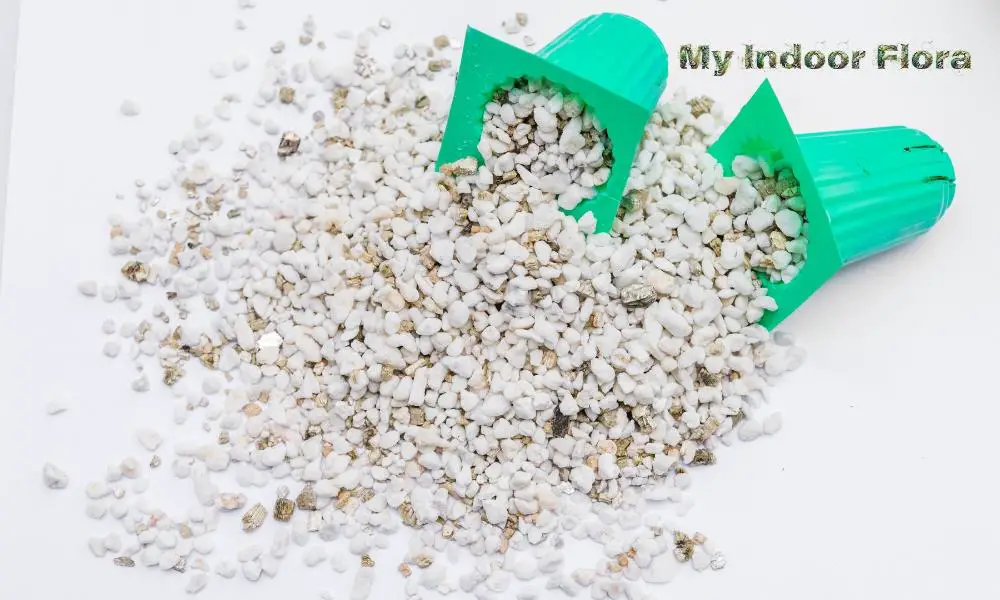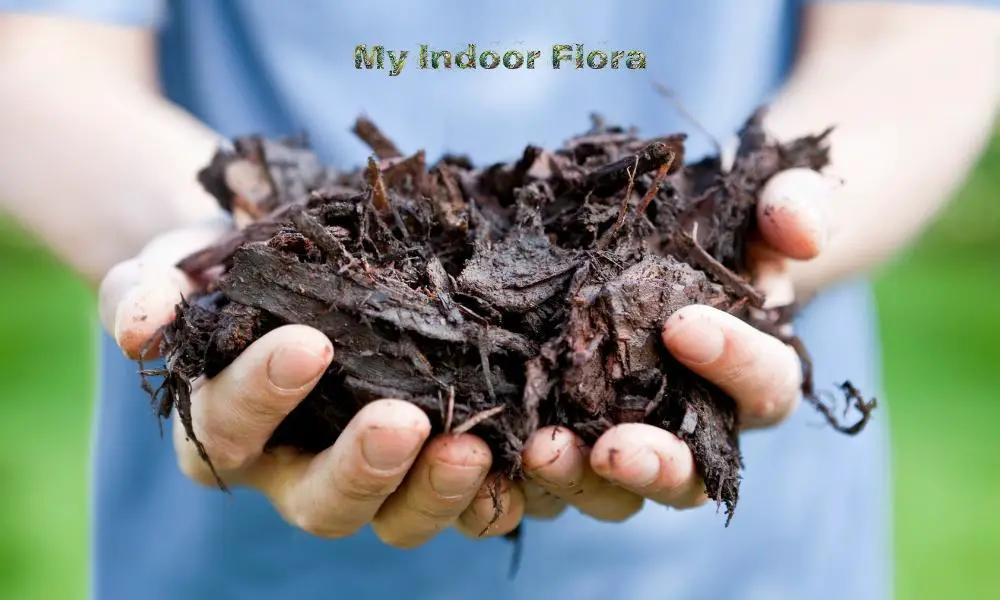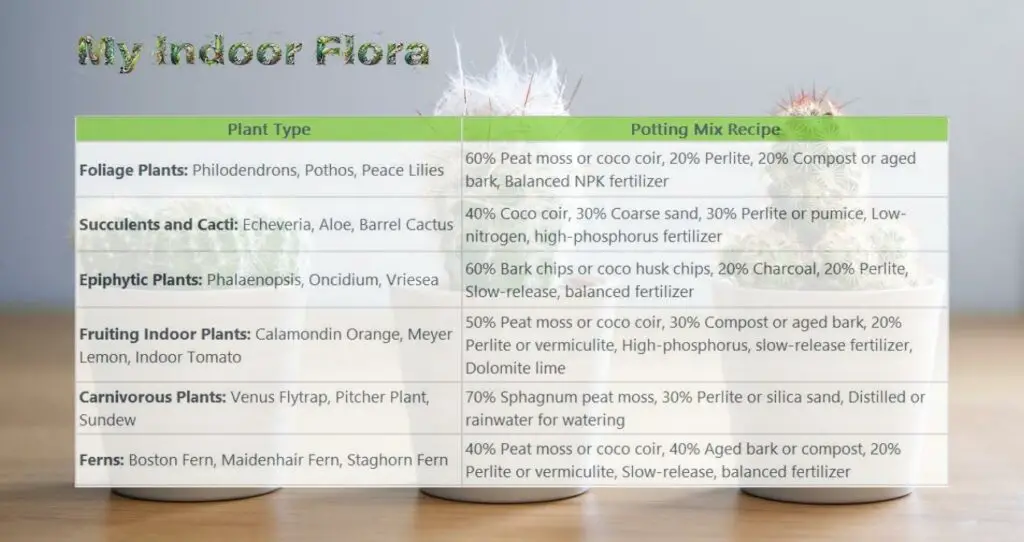Indoor plants have been scientifically proven to improve air quality, reduce stress levels, and enhance our overall well-being, making them an essential addition to modern living spaces. A critical factor in the success of growing and maintaining indoor plants is the potting mix they are planted in.
According to a study published in the journal Environmental Science & Pollution Research, a well-formulated potting mix can significantly impact a plant’s growth, health, and resilience to pests and diseases.
This article will provide an in-depth guide to creating DIY potting mix recipes tailored specifically for various indoor plant types, ensuring they receive the appropriate nutrients, drainage, and aeration needed for optimal growth. We’ll delve into expert opinions, research, and scientific data to offer practical and actionable tips for crafting the perfect potting mix for your beloved indoor plants.
What are the key components of a DIY potting mix?
A good potting mix serves as the foundation for healthy and thriving indoor plants. It should provide adequate aeration, drainage, and nutrients, as well as retain enough moisture to support the plant’s needs. The following components are essential for most potting mixes.
Peat moss or coco coir

Peat moss and coco coir serve as the primary base for many potting mixes. They retain moisture and provide aeration, allowing the plant’s roots to access oxygen. While peat moss is widely used, it is a non-renewable resource. According to Dr. Douglas F. Welsh, a professor and extension horticulturist at Texas A&M University, coco coir is a more sustainable alternative. It is a by-product of the coconut industry and exhibits similar properties to peat moss, making it an environmentally friendly option.
Perlite or vermiculite

Perlite and vermiculite are both lightweight, porous materials that improve aeration and drainage in potting mixes. Dr. Linda Chalker-Scott, an extension urban horticulturist at Washington State University, explains that perlite, an expanded volcanic rock, aids in drainage and prevents soil compaction. Vermiculite, a heat-expanded mica mineral, retains more water and nutrients, making it suitable for moisture-loving plants.
Compost or aged bark

Compost and aged bark provide essential nutrients to the plants and improve the mix’s overall structure. They are rich in organic matter and help maintain a healthy balance of microorganisms in the soil. Dr. George L. Taber, a retired horticulture professor from the University of Florida, emphasizes the importance of using well-aged compost or bark, as fresh materials can rob plants of essential nitrogen.
Additional amendments based on plant type
Depending on the specific needs of your indoor plants, you may need to include additional amendments such as sand, bark chips, charcoal, or various types of fertilizer. According to Dr. John Dromgoole, a horticulturist and owner of The Natural Gardener in Austin, Texas, tailoring your potting mix to suit your plant’s requirements can greatly improve its overall health and growth.
How can you determine the ideal potting mix recipe for your indoor plants?
To create the perfect potting mix for your indoor plants, you must first understand the plant’s natural habitat and growing conditions. Different plant types have distinct requirements for drainage, aeration, and nutrient content. By assessing the plant’s specific needs, you can develop a tailored potting mix that closely mimics its natural environment. Dr. Bodie Pennisi, a professor of horticulture at the University of Georgia, suggests observing the plant’s growth habits, leaf characteristics, and root system to determine its potting mix requirements.

What is the best DIY potting mix recipe for common indoor foliage plants?
Foliage plants like Philodendrons, Pothos, and Peace Lilies are popular choices for indoor gardening. They typically require a well-aerated, moisture-retentive, and nutrient-rich potting mix. Based on expert recommendations, the following recipe can be used as a starting point:
Foliage plant types: Philodendrons, Pothos, and Peace Lilies
Potting mix recipe
- Peat moss or coco coir (60%)
- Perlite (20%)
- Compost or aged bark (20%)
- Balanced NPK fertilizer (according to package instructions)
Tips for optimizing the potting mix
Dr. Leonard Perry, a horticulture professor emeritus from the University of Vermont, recommends regularly monitoring the plant’s growth and adjusting the potting mix components as needed. For example, if the plant appears to be retaining too much moisture, you can increase the proportion of perlite to improve drainage. Conversely, if the plant dries out too quickly, consider adding more peat moss or coco coir to increase moisture retention.
How can you create a well-draining potting mix for succulents and cacti?
Succulents and cacti require a well-draining potting mix that allows for rapid drying between waterings. Overwatering can lead to root rot, a common problem with these plants. The following recipe is designed to provide the ideal growing environment for succulents and cacti:
Succulent and cacti types: Echeveria, Aloe, and Barrel Cactus
Potting mix recipe
- Coco coir (40%)
- Coarse sand (30%)
- Perlite or pumice (30%)
- Low-nitrogen, high-phosphorus fertilizer (according to package instructions)
Tips for maintaining proper drainage
Dr. Mahr, a horticulture expert from the University of Wisconsin-Madison, suggests using a pot with drainage holes and a saucer to catch excess water. Avoid letting the plant sit in standing water, as this can cause root rot. Additionally, you can place a layer of gravel or small rocks at the bottom of the pot to improve drainage further.
What is an ideal DIY potting mix recipe for epiphytic plants like orchids and bromeliads?
Epiphytic plants, such as orchids and bromeliads, grow on other plants in their natural habitat and have unique potting mix requirements. They need an airy and moisture-retentive mix that allows for adequate oxygen exchange around their roots. The following recipe is tailored for these plants:
Epiphytic plant types: Phalaenopsis, Oncidium, and Vriesea
Potting mix recipe
- Bark chips or coco husk chips (60%)
- Charcoal (20%)
- Perlite (20%)
- Slow-release, balanced fertilizer (according to package instructions)
Tips for creating an airy and moisture-retentive mix
Dr. Yin-Tung Wang, a renowned orchid expert and former professor at Texas A&M University, advises using a pot with plenty of drainage holes and repotting epiphytic plants every two to three years to refresh the potting mix. Additionally, ensure that the bark chips are of an appropriate size for your plant—smaller plants require finer bark, while larger plants need coarser bark for optimal growth.
How to prepare a nutrient-rich potting mix for fruiting indoor plants like dwarf citrus trees and tomatoes?
Fruiting indoor plants, such as dwarf citrus trees and tomatoes, require a nutrient-rich potting mix to support fruit production. The following recipe is designed to provide the necessary nutrients for optimal growth and fruiting:
Fruiting indoor plant types: Calamondin Orange, Meyer Lemon, and Indoor Tomato
Potting mix recipe
- Peat moss or coco coir (50%)
- Compost or aged bark (30%)
- Perlite or vermiculite (20%)
- High-phosphorus, slow-release fertilizer (according to package instructions)
- Dolomite lime (1 tablespoon per gallon of mix)
Tips for maintaining nutrient levels
Dr. Jacqueline Kowalski, an extension educator at Ohio State University, emphasizes the importance of regularly monitoring your fruiting plants’ nutrient needs. She recommends supplementing the potting mix with additional high-phosphorus fertilizer during the flowering and fruiting stages, as these plants require more phosphorus to support fruit production. Additionally, Dr. Kowalski suggests checking the soil pH periodically and adjusting it as needed with dolomite lime to maintain a slightly acidic to neutral pH, which is ideal for most fruiting plants.
How to adapt potting mix recipes for unique plants like carnivorous plants and ferns?
Some indoor plants have specific potting mix requirements that differ significantly from standard recipes. Carnivorous plants, for example, need a nutrient-poor, acidic mix, while ferns prefer a moisture-retentive, high-humus mix. To create a suitable potting mix for these unique plants, consider the following recommendations:
Carnivorous plant types: Venus Flytrap, Pitcher Plant, and Sundew
Potting mix recipe
- Sphagnum peat moss (70%)
- Perlite or silica sand (30%)
- Distilled or rainwater for watering (tap water can contain minerals harmful to carnivorous plants)
Tips for maintaining an acidic environment
Dr. Barry Rice, a carnivorous plant expert and author of “Growing Carnivorous Plants,” recommends avoiding the use of fertilizer and lime in the potting mix, as these can harm the plants. Additionally, he suggests using distilled or rainwater to water your carnivorous plants, as tap water may contain minerals that can damage their roots.
Fern types: Boston Fern, Maidenhair Fern, and Staghorn Fern
Potting mix recipe
- Peat moss or coco coir (40%)
- Aged bark or compost (40%)
- Perlite or vermiculite (20%)
- Slow-release, balanced fertilizer (according to package instructions)
Tips for maintaining a moisture-retentive environment
Dr. Paul Thomas, a horticulture professor at the University of Georgia, advises using a pot with drainage holes to prevent waterlogging while maintaining a consistently moist environment for your ferns. He also suggests placing a saucer filled with water and pebbles beneath the pot to increase humidity around the plant, as ferns typically thrive in high-humidity environments.
Conclusion
Creating the perfect DIY potting mix for your indoor plants is a delicate balance of understanding their specific needs and tailoring the mix to mimic their natural growing conditions. By incorporating expert recommendations and research into your potting mix recipes, you can ensure that your indoor plants receive the proper nutrients, drainage, and aeration needed to thrive. Remember to observe your plants closely and make adjustments as needed to maintain their health and vitality. Happy gardening!
